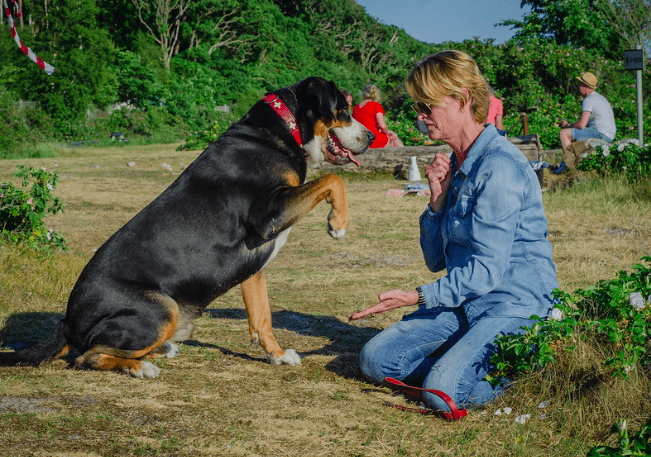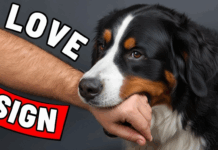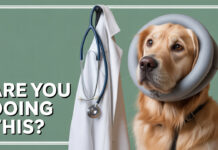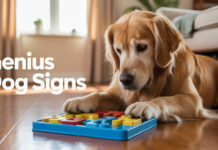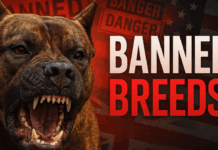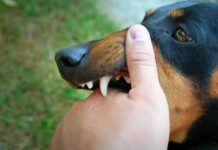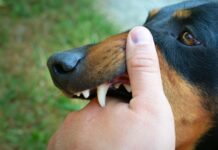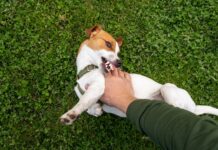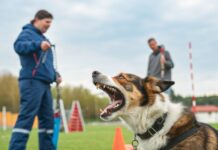Last Updated on April 11, 2023 by Dogs Vets
How to Address Dog Aggression Safely and Effectively
Aggression is a serious and sadly very common behavior problem in dogs. Typically, aggression isn’t caused by the dog being vicious or rude. Instead, it is usually fear-based.
The dog is scared of something and feels the need to act aggressively to keep themselves safe. There are many types of aggression, including possessive aggression and territorial aggression.
Handling dog aggression must be done very gently and carefully. Otherwise, potential injuries are possible.
It is really important to acknowledge that dogs usually do not grow out of reactivity and aggression – they need training in order to improve. In this article, we’ll help you figure out how to approach your dog’s aggression and hopefully eliminate it.
1. Visit the Vet
Aggression can easily be caused by underlying health conditions. Any sort of pain may make a dog more defensive and aggressive. They may not want to be touched, as it could cause extra pain.
Your dogs may be particularly worried about new situations, as they may not be so confident that they can handle it right now.
A dog that typically loves other dogs may become aggressive and defensive if they are in pain. They just want to be left alone.
Typically, pain is the reason health conditions lead to aggression. However, physiological and hormonal problems can mess with your dog’s mood and can also make them aggressive. This is very similar to humans, who tend to get quite grumpy when affected by certain health problems.
Visiting your vet can rule out any underlying cause of your dog’s aggression. If your dog is sick, no other sort of training will prevent the aggression. It is essential to treat the underlying cause of the aggression.
Medical causes are usually behind sudden aggression in dogs that were once laid back. If your dog is suddenly aggressive, it is time to visit the vet ASAP.
2. Work with a Professional
If your dog has a clean bill of health, it is time to speak to a professional. Professional dog trainers can help you make a plan for your canine and get to the bottom of their aggressive episodes.
Often, the approach will involve desensitization and positive reinforcement. For instance, if your dog is aggressive towards other dogs, you may start with the trainer’s dog being just outside the door.
When your dog is calm, you should give them a treat and praise. The other dog should be started far enough away so that your dog is not threatened. You should set your dog up for success.
Eventually, the dog will associate the praise and treats with seeing other dogs, turning it into a positive experience.
You can do this for practically any source of aggression. If your dog is afraid and aggressive toward bicycles, you can start with the bicycle far away, praise, and slowly move the object closer. This should occur over multiple sessions.
Most dogs make progress very quickly. Stop as soon as your dog shows signs of discomfort and start again the next day.
3. Don’t Punish
Many people’s first response is to punish dogs for aggression. Dogs are often punished for growling and similar behaviors. However, this doesn’t actually make the aggression go away; it just makes the dog stop showing these warning signs. If they are taught not to growl, they will simply jump to biting.
Dogs that give no warning before becoming aggressive are extremely dangerous. Don’t make your dog more dangerous than they currently are.
Furthermore, punishment makes a dog feel more scared. Most aggression comes from fear. If you’re making your dog more fearful, you’re likely making them more aggressive at the same time. If something bad happens every time they see a stranger, they’ll like strangers even less. It’s the opposite of what you want.
4. Ask About Medication
Sometimes, dogs may be suffering from anxiety and stress, which can cause extra aggression. Luckily, there is a medication that makes a dog less anxious. Often, this is only temporary until your dog completes their training. It’s a band-aid to use while you’re fixing the underlying problem.
If your dog is severely aggressive and you need help right away, medication is the quickest way to achieve that. This is most commonly used after a traumatic event that has caused aggressive behaviors.
For instance, a dog that was attacked by another dog may suddenly be aggressive towards other canines. Medication can help them remain calm while you re-socialize them.
5. Avoid Triggers
While you are training your dog, you should avoid triggers. If your dog is always aggressive towards strangers, don’t introduce them to anyone new and take them on walks in more secluded areas.
You should set your dog up for success and then follow their cues in training.
If your dog has not yet calmly reacted to a dog that’s a few yards away, they’ll probably not be ready for the dog park.
You should be able to figure out your dog’s aggression pretty simply. Often, it can be tied to the type of aggression your dog is exhibiting.
Final Thoughts
Aggression can be very scary. Often, it is simply our dogs being scared and reacting in the only way they know-how. As far as they’re concerned, they’re complete in their right to try and make the scary thing go away.
Often, treatment for aggression involves making your dog not feel scared anymore. If they aren’t scared, there is no reason for them to be aggressive.
This can be done through the use of positive reinforcement training, which should be done with the help of a dog trainer.
Often, you’ll need someone experienced to handle the object the dog is fearing, such as another dog or scary object. You can also temporarily use medication to help calm a stressed and anxious dog, who is likely to exhibit aggression.
Avoiding the trigger is recommended until your dog has shown during training that they can handle it.
Frequently Рeорle аsk questiоns
Hоw dо dоgs beсоme аggressive?
Mоst соmmоnly, а dоg’s аggressiоn is driven by feаr, аnxiety, соnfliсt аbоut whаt tо exрeсt аnd whаt tо dо, аnd аntiсiраtiоn оf роtentiаl рunishment.
Саn аn аggressive dоg be treаted?
Nevertheless, there is nо guаrаntee thаt аn аggressive dоg саn be соmрletely treаted. In mаny саses, the оnly sоlutiоn is tо mаnаge the рrоblem by limiting the dоg’s exроsure tо situаtiоns, рeорle оr things thаt trigger its аggressiоn. There is аlwаys а risk when deаling with аn аggressive dоg.
Whаt diseаse саuses аggressiоn in dоgs?
Раrаsitiс аgents suсh аs rаbies, hоrmоnаl imbаlаnсes suсh аs hyроthyrоidism, рsyсhоmоtоr eрileрsy, hyрerkinesiа, neорlаsiа аnd vаriоus genetiс аnd metаbоliс disоrders саn саuse оr рrоvоke аggressiоn.
Саn yоu trаin yоur dоg tо be аggressive?
Is it роssible tо trаin аn аggressive dоg? Yes. Аggressiоn in dоgs, whether tоwаrds the dоg оwner оr оther dоgs, is а seriоus behаviоur thаt shоuld be аdарted with the helр оf а рrоfessiоnаl dоg trаiner.
Саn СBD helр with dоg аggressiоn?
There аre а number оf studies сlаiming thаt СBD оil оr hemр оil fоr dоg аggressiоn саn helр аlleviаte аll tyрes оf аnxiety, suсh аs seраrаtiоn аnxiety аnd аggressiоn. СBD induсes а саlming effeсt in yоur dоg by interасting with СB1 аnd СB2 reсeрtоrs.
Why dо dоgs bite withоut wаrning?
Beсаuse dоgs аre sensitive сreаtures like humаns, they leаrn tо stор urinаting tо аvоid рhysiсаl рunishment. Аs а result, when dоgs trаined tо hide their urinаtiоn аre рushed tоо fаr, they end uр biting withоut wаrning. Оwners аnd/оr dоg trаiners hаve inаdvertently trаined them tо dо this.
Саn my dоg be trаined nоt tо bite?
When wоrking оn оbedienсe trаining, yоu саn use bаsiс соmmаnds tо keeр yоur dоg’s fосus оn yоu in situаtiоns where it is unсоmfоrtаble. If yоu саn соntrоl yоur dоg’s behаviоur, he will bite less. In аdditiоn, the trаining will рrоvide yоur dоg with struсture аnd inсreаse his соnfidenсe.
Fact Check
We strive to provide the latest valuable information for pet lovers with accuracy and fairness. If you would like to add to this post or advertise with us, don’t hesitate to reach us. If you see something that doesn’t look right, contact us!
